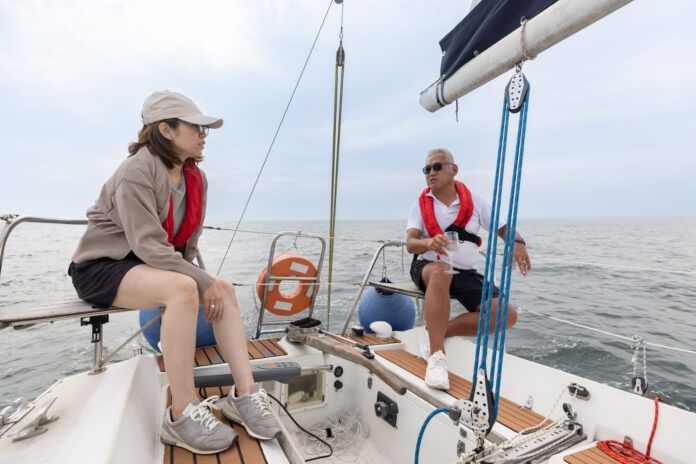
Autopilot is not autodrive. The International Rules of the Road (COLREGS) makes your responsibility clear: You must keep watch. There are no exemptions for radar, AIS, autopilot, catnaps, or even while at anchor. No matter how advanced systems get, and how well it is integrated into your electronics, a human must be in the loop.
KEEP A LOOK-OUT
According to COLREGS (Rule 5), every vessel shall at all times maintain a proper look-out by sight and hearing as well as by all available means appropriate in the prevailing circumstances and conditions so as to make a full appraisal of the situation and of the risk of collision.
Although we praise autopilots for their ability to free up a hand, relieve monotony, and often outperform a human through fatigue-proof consistency, they have limitations and idiosyncrasies. Today we are focused on tillerpilots (see installation tips here) but many of these principles are universal across all autopilot types.
LOSS OF POWER
If the power drops for just a split second, the pilot will revert to manual and the heading is lost. The boat will slowly turn to one side and not stop turning. In the case of a tillerpilot, jostling a worn plug is the common culprit. Step carefully around the plug when the weather is rough. Replace aging plugs and keep them well-greased. Placing the plug in a protected location with some strain relief is smart.
Low-battery voltage (less than about 12.1 volts) will cause autopilots and many other electronics to drop out. Low-battery charge, low temperature, or a big draw from starting the engine or running a windlass can all contribute.
MANUAL COURSE LOCK ERROR

Just as the sea state or damping setting instructs the pilot to time-average compass readings before reacting, the pilot locks manual settings based on the average heading over the previous seconds. If you are still turning, or just completed a turn, the new course setting will be based on that average and will be off by 10 to 30 degrees. Wait 5 to 15 seconds after completing any turn before pressing “Auto.” New course settings based on way points, or course, are immediate.
DISENGAGED PUSH-ROD
We’ve had push-rods bounce off many times, either from waves or a careless knee. The boat will wander off course and you may or may not hear the off-course alarm. Wear on the push-rod socket might be the cause; you might have to replace it. Another solution is to make a new end from stiff rubber hose. Remove the worn pushrod tip, cut a 2½-in. length of ¾-in. ID stiff rubber or vinyl, and drill a ¼-in. hole near one end.
The hole will be undersized, so you will want to work the drill back and forth until you have a snug push fit on the tiller-pin. Secure this on the push-rod with a hose clamp and fine tune the length by checking that the tiller has the same range of motion at both extremes of travel.
YAWING
Upwind a boat should be well-balanced, carrying on in a straight line with only minor adjustments of the helm. But off the wind, the simple-minded tillerpilot cannot anticipate the effect of waves and gusts. Using the “Wind” setting, the apparent wind swings aft when a boat slows after a wave passes under it. The tillerpilot turns the boat to windward to compensate, the boat quickly accelerates, a following wave adds more acceleration, inducing yaw and pushing the stern to leeward, and then suddenly the boat is pointing way too high. The pilot makes a large leeward adjustment. But by this time the wave has passed, the boat has slowed, and the apparent wind has swung far aft again. The cycle repeats over and over, with the boat yawing through 30 to 40 degrees. The crew is dizzy and the pilot works itself to death.

To stop this, set the pilot on “Compass” and trim the sails with enough twist to tolerate a range of wind angles. The boat will still yaw with each passing wave, since the tillerpilot can anticipate waves and gusts like a human, but at least it will overreact less.
Adjusting helm balance also helps. Just as the pilot benefits from helm balance going to windward, it helps to balance the boat off the wind. This means carrying a larger headsail, and reefing the main earlier than normal. For example, a reacher and reefed main will balance better and yaw less than a jib and full main. A large genoa and reefed main can be a good combination. A partially rolled genoa and a full main are a recipe for yawing.
DOUBLE-CHECK POSITION

You are running a course from waypoint to waypoint…or are you? As we have shown, there are many ways that the tillerpilot can stray from its heading when it’s not being monitored. Thus, you must maintain situational awareness at all times, using both visual bearings and your boat’s electronics. Your chartplotter may go out at the same time you lose your autopilot if there is a power supply issue.
DISENGAGING THE PILOT
Make sure that all crew members know how to disengage the autopilot. There have been some sad stories when the skipper fell off and no one could figure out how to stop the boat.






































